Modular lighting system and method of installation
a module and lighting technology, applied in the field of modules, can solve the problems of inability to accommodate complex curvilinear shapes, inability to maximize the efficiency of overlapping systems, uneven light distribution of coves, etc., and achieve the effect of convenient installation and easy installation
- Summary
- Abstract
- Description
- Claims
- Application Information
AI Technical Summary
Benefits of technology
Problems solved by technology
Method used
Image
Examples
Embodiment Construction
[0046]Referring now to the drawings, wherein like reference numerals indicate like elements, there is shown in FIGS. 1A-1B and 2A-2B a lighting system 100, or portions thereof, in accordance with a first exemplary embodiment of the present invention. The lighting system 100 includes a plurality of light fixtures, (composed of flexible special power cable segments which connect individual enclosures) 102 holding in-place sections of a tubular lamp (e.g. cold cathode fluorescent lamp) 101. The system 100 is intended for (but not limited to) use in indirect lighting environments, such as within a cove (not shown in FIGS. 1 or 2) to illuminate a ceiling.
[0047]FIG. 1A depicts one fixture 102 with portions of the adjacent fixtures 102, shown just prior to electrical connection and mounting of the fixtures 102. FIG. 1B shows the fixtures 102 of FIG. 1B as they would be mounted. The arrows at the left hand side of this Figure depict the electrical connection that is made, as shown by the fi...
PUM
| Property | Measurement | Unit |
|---|---|---|
| voltages | aaaaa | aaaaa |
| voltages | aaaaa | aaaaa |
| voltage | aaaaa | aaaaa |
Abstract
Description
Claims
Application Information
 Login to View More
Login to View More - R&D
- Intellectual Property
- Life Sciences
- Materials
- Tech Scout
- Unparalleled Data Quality
- Higher Quality Content
- 60% Fewer Hallucinations
Browse by: Latest US Patents, China's latest patents, Technical Efficacy Thesaurus, Application Domain, Technology Topic, Popular Technical Reports.
© 2025 PatSnap. All rights reserved.Legal|Privacy policy|Modern Slavery Act Transparency Statement|Sitemap|About US| Contact US: help@patsnap.com



